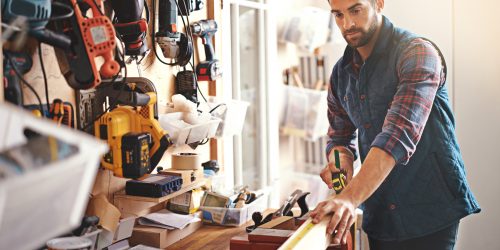Purchasing guide: Choosing your workstation equipment
The workspace has a significant influence on well-being and quality of life at work. An unsuitable environment has an impact on the physical and mental health of employees, as well as on a company’s performance. Companies therefore need to invest in ergonomic office furniture and ensure the safety and satisfaction of their employees. Here are the key tips for choosing and equipping your workshop.
Why build an ergonomic workstation?
On average, an employee sits at their desk for more than 7.5 hours a day, which leads to physiological effects ranging from mild acute pain to the development of musculoskeletal disorders (MSD). Among those suffering from a work-related health condition, 60% identify MSDs as their most serious disorder. In this regard, the design of workstations is an essential preventive measure, which also significantly improves the comfort of staff.
Ergonomic equipment to prevent physical health problems
In the medium term, working on a computer can lead to pain in the wrists and arms. Such pain should be taken seriously, as it may be an indicator of musculoskeletal disorders.
In the third European Survey of Enterprises on New and Emerging Risks (ESENER), 65% of the companies surveyed listed repetitive movements of the hands and arms as the main risk factors for the onset of MSDs.
The resulting absenteeism leads to a drop in productivity. The atmosphere can become tense, and the quality of social relationships can deteriorate. This damages the image of the company, which sees its authority and its entire organisation disrupted.
Office equipment can bring real benefits to staff in terms of comfort, ability to concentrate and prevention of fatigue.
Workstation design to prevent mental health problems
A poorly optimised workstation can also lead to psychosocial disorders. Indeed, physical health problems and psychological discomfort are closely linked. The prevention of mental health problems in companies therefore also entails the design of a healthy working environment. Noise, lack of light or storage are all risk factors for stress-related workplace discomfort. This problem is far from simply anecdotal: one in two European workers say they are stressed at work.
Equipment for an ergonomic workstation
The design of an office with ergonomic furniture and equipment is a lever for employee motivation. When choosing your equipment, there are a few criteria and best practices that should be taken into account.
Choosing the right office furniture for your workstation
In office work, the neck, back and joints are particularly vulnerable. To reduce stress on these sensitive areas, office design must meet specific requirements.
Which criteria should be taken into account when choosing products and accessories?
Numerous jobs in the service sector involve sedentary work. Workers spend a great deal of time sitting in an office chair in front of a computer screen. Workstation equipment should be chosen based on the specific needs of each employee. The equipment must be ergonomic and adjustable according to the following criteria:
- The employee’s body shape (height, weight, etc.);
- Their physical condition (known medical problems);
- Their age;
- Their equipment preferences.
Good working posture is essential to prevent fatigue and tension. In terms of the head, the screen should be 2 to 3 centimetres below eye level, to reduce exposure to artificial light while minimising neck flexion. The feet should rest flat on the floor and the knees should be slightly higher than the buttocks.
Best practices to adopt in the office to ensure health and safety
The basic rule of an ergonomic approach is to allow the body as much freedom of movement as possible to meet its physiological needs. Even in office work, it is important to vary positions throughout the day or to move around a little on a regular basis.
Regular training is also a solution to consider, as it helps to maintain good posture at work and thus prevent discomfort.
To prevent accidents at work, it is also essential for employees to follow safety rules. Finally, it is advisable to take breaks and stretch before resuming sedentary activities.
A few products and accessories for designing an ergonomic workstation
To prevent stress and pain throughout the day, it is important to choose ergonomic products, like display screen equipment (DSE) and practical accessories. Whether in the office or the workshop, buying a suitable workstation is essential.
Choosing a desk and a chair
An office chair should be chosen according to the employee’s profile. The chair should allow them to sit upright, with their knees slightly higher than their buttocks.
If their body type does not allow them to reach this posture, they should use a footrest to reduce the strain on their lower back and knee joints. This also prevents a forward posture, which puts a lot of strain on the back and lumbar vertebrae.
To encourage movement without getting in the way of work, a monitor turntable is a good solution. This also makes teamwork easier by avoiding the need to twist and turn. A corner bracket monitor mount, meanwhile, offers a comfortable viewing height.
Ergonomic chairs reduce back problems and come in many shapes and sizes. There is the sit-stand model, which offers the worker considerable freedom of movement. This is particularly suitable for workshop work. Kneeling chairs allow you to lean forward to reduce the strain on your lower back.
As for the desk, it is advisable to opt for a height-adjustable model whenever possible.
Ergonomic accessories
Numerous accessories make it possible to adjust the screen to an ideal position with the help of a fixed or swivel stand. The height of the chair is also an important factor in preventing pain. This is why new equipment has been designed to better adapt to the physiological needs of individuals and to reduce the strain in these vulnerable areas. These include, for example, wrist rests, which have a proven effect in preventing carpal tunnel syndrome. Another important innovation is the ergonomic mouse. Its vertical design allows the wrist to assume a more natural position and offers a high level of comfort.
The right equipment to ensure everyone’s safety in the workshop
In the warehouse or the workshop, the health and safety of workers are put to the test. Hard physical work and a stressful working environment require workstations to be equipped with ergonomic products.
To prevent MSDs and other debilitating work-related disorders, the best possible seating should be provided. Height-adjustable sit-stand chairs are ideal for this. Employees who spend a lot of time on the production line can use an anti-fatigue mat. Finally, employees who handle heavy loads may require hand trucks, forklift trucks and electric pallet trucks.
Designing the workstation
The working position and ergonomic furniture have a significant impact on the level of fatigue experienced by staff, but they are not the only elements to be taken into consideration. Careful consideration of office acoustics and storage options also play a major role in stress prevention.
Organising spaces
Workstation layout has a considerable influence on the overall well-being of employees. There are a number of solutions for improving the comfort and ergonomics of workstations: the installation of a monitor stand with integrated drawers, the use of suitable storage furniture or the organisation of spaces to give everyone more privacy.
Ergonomists also recommend placing filing or storage areas slightly away from desks to encourage movement. When it comes to ergonomics, it is sometimes the little things that make all the difference and make everyone’s working life more pleasant, both for the body and for the mind.
Fostering a good working environment
Well-being at work must also take into account acoustics, lighting and decoration. Noise pollution causes stress, but also fatigue, which is detrimental to everyone’s productivity: purchasing a suitable solution quickly pays for itself.
In the workshop, employees can wear earmuffs, for example. Natural light is also important, as it has a positive impact on morale and concentration. Light acts as an antidepressant and combats fatigue.
Air quality is one of the most important factors for well-being at work, so it is a good idea to equip the premises with pollution-removing plants.
Finally, allowing employees to take ownership of their workspace is a good way to increase their commitment. In a personalised environment, workers feel more at home.
Companies are having to address the new challenges of well-being at work. The prevention of physical and mental health problems is a hot topic. A healthy working environment and the right equipment are essential to limit psychosocial risks that are detrimental to both companies and their employees.
To find out more about workstation equipment, read our purchasing guide on new eco-friendly office and warehouse products.






